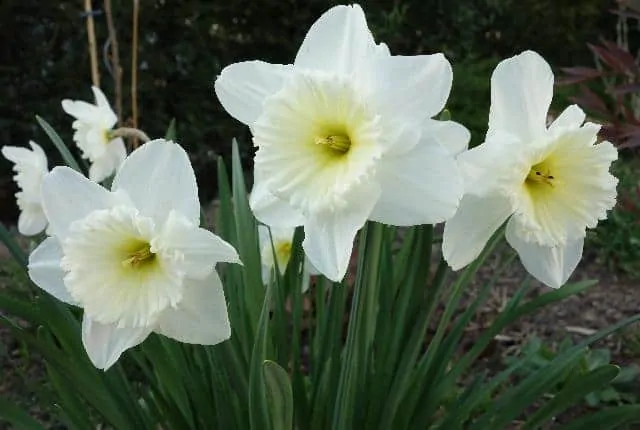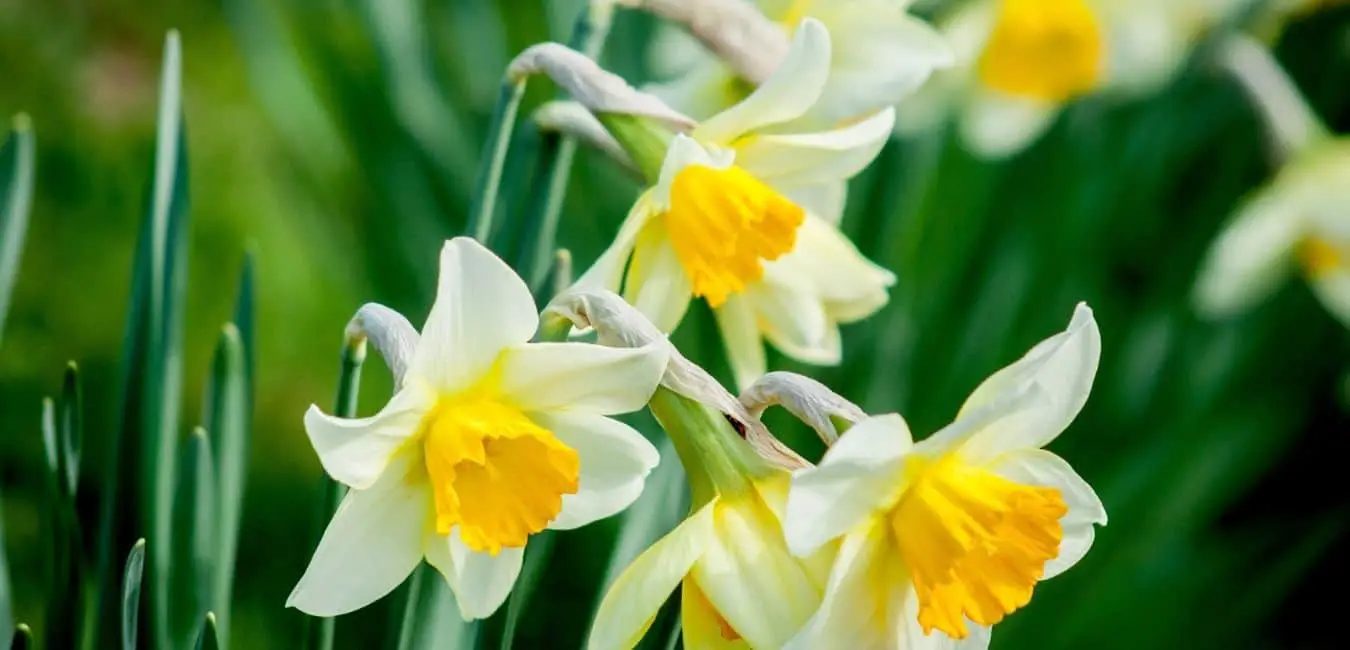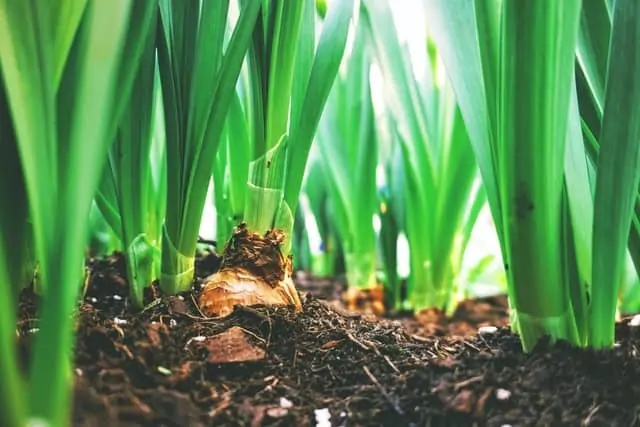Today we will learn How To Propagate Daffodils?- Daffodils are beautiful yellow spring flowers. It is a herbaceous plant with the botanical name-“Narcissus pseudonarcissus“. In the US daffodils can grow in hardiness zone 3 to 11. It can simply adapt to every growing region in the states with a wide range of hybrid varieties. Daffodils gain popularity in the US in the 19th century. Their bright yellow flower gives a fresh earthy look to the spring garden. It is one of the easiest spring plants to grow. Daffodils don’t require much care and attention to grow and expand. It can thrive in a variety of soil types from black loam to red sandy soil. All it needs is proper nutrition with lots of sunlight and water.
A Daffodil plant can propagate through bulbs and seeds. It requires an optimum 60 to 65 degrees Fahrenheit throughout the growth period. The soil should be soft nutritious and well-drained. The soil Ph must lie around 6.8 for best bloom. Although it can survive in soil with acid ph 5.9 to slightly alkaline ph 7.3.
The daffodil plant has two main parts the leaf or foliage and the Bulbs or the root section. The Daffodil bulbs can range from 3 to 5 inches in diameter. The light fleshy stem or leaf can length to 12 inches in optimum conditions. A healthy daffodil plant can grow up to 15 inches tall with a 5 to the 7-inch bulb.

Check out my previous post: What are Plantable Pencil, Paper, and Cards?
Can You grow a daffodil from the flower?
Yes, Technically we can grow Daffodils from flowers. The Daffodil flower forms a seed pod after successful pollination. It bears a large tubular seed pod. Several dark black seeds forms inside this pod. These seeds can germinate and grow into new daffodil plants. Each flower can develop 10 or more seeds, most of these are viable for reproducing.
Indeed, a flower can’t develop into a new daffodil plant though seeds can. So it is good to say you can prepare new plants from daffodil flowers.
How do You Take Cutting from daffodils?
Daffodil leaf ends are attached to the bulbils. These are flat notches that can propagate into new plants. We can either take cuttings from the bulbil notches or take out bulbs to grow the daffodils.
Technically Daffodil doesn’t propagate through plant cutting. Instead, you can make cutting out of daffodil bulbs. Either you will need a vegetative part or stem to grow or you can use the seeds to grow daffodils.
Bulbs or Bulbils are the only vegetative stem part that can propagate into new daffodil plants. It is possible to make cuttings or sections out of these bulbs. There are two ways to make cuttings of daffodil bulbs. The first one is called sectioning and the second is partial groove cuts.
You can cut pieces or sections of daffodil bulbs and grow them individually. Partial cutting can be done by making a 3 v shape groove without complete direction. 10 to 15 bulblets can develop from these cutting and they will be ready to bloom within 3 years.
Can you Root daffodils in water?
Yes, Daffodils can root in water. Daffodils can root in plain water Though they cannot survive in submerged water. You can put the bulb in a water bowl where only the root contacts the water. Suspend the daffodil bulbs over a glass of water with a skewer or a toothpick to hold it above water level.
Place the entire arrangement in a warm well-lit location indoors for a couple of weeks. Change the water twice a week and observe new white root growth. New shoots and leaves can come out within 6 to 8 weeks.
Although this method is not an ideal way to grow daffodils yet an interesting way indeed. Try this method as an experiment and share your observation and thoughts with us.

You should read this: How to Divide and Grow Oriental Orange Tiger Lily?
How to multiply Daffodils?
Daffodils can multiply with their seeds or from bulbs. In fact, Both propagation form seeds and bulbs are equally viable. Seeds come from the flowers after successful pollination. Whereas The bulbs are the basal section of the plant stem. It is a vegetative part and can propagate asexually to form a new plant.
Grow a new daffodil plant from the seeds. It only requires spreading seeds over soft moist soil. Let it germinate in full sun for 2 to 4 weeks. Later you can confirm an 80 to 90% germination rate with the seeds.
If you use a healthy bulb to multiply daffodils then you can get 100% success every time with little care. All you need is to place the bulb in a healthy soil mix and let it grow.
Every year the parent daffodil lant will develop several baby bulbs around the main bulb. You can again separate and multiply daffodils with these baby bulbs.
Methods to Propagate Daffodils
Daffodils can propagate in two different ways- Sexually and Asexually. Daffodil Flower is the main location for the plant to reproduce sexually. It includes the transfer of pollen grains from the anther to stigma. Pollination is mostly done by natural pollinators such as honeybees and butterflies. The pollinators fertilize the flower and form seed pods. Each seedpod contains several dark black seeds. Finally, the seeds can propagate and grow into a plant.
Asexually Daffodils can propagate through Bulbs and bulbils. Bulbs are the round basal portion of the plant whereas bulbils are notch at the joint of leaf and stem.

10 Best Summer Flowers to Grow in April and May
Daffodil seed pods- Seed formation
Daffodil flowers end with the formation of round ovate seed pods. These large 1 to 2-inch seedpods bear 6 to 1 black seeds. Each flower can develop only one seedpod that can contain 10 viable seeds. These daffodil seeds are hard and strong to survive cold and heavy rain. In this way, these seeds can stay alive in the soil for a couple of dormant seasons waiting to sprout in the spring. The seeds are round and black. Each seed size is up to 0.3 cm and weighs up to 1/2 gm.
The seedpod and seed form after successful pollination in the daffodil flower. It starts with bees flying from one daffodil to another in search of nectar. Meanwhile, it carries some pollen grain from the anther to the stigma and pollinates the flower. The pollinated daffodil flower will fertilize and form a seedpod full of seeds.
Growing Daffodils from Seeds?
You can easily grow daffodils from its seeds. Either collect some seeds from a seedpod or buy them from a seed store. Start with the soil preparation.
Mix 30% garden soil with 30% compost 20% coco peat, 10% sand, and 10% bonemeal fertilizer to grow the daffodil seeds.
- Fill a seedling tray evenly with 4 inches of soil mix. This tray or container must have proper drainage holes.
- Spread the seed evenly over the soil surface and cover it with 1 to 2 inches of coco peat and soil mix.
- Moisten the soil mix and place it in full sun for 3 to 4 weeks. Don’t let the soil dry completely.
- The seed will germinate within a month of sowing depending on the moisture and temperature.
- Feed the baby seedling after 15 days with balanced liquid fertilizer.
- The seedlings will take 3 or more years to mature and bloom. Just wait and watch out for the growth of these lovely daffodils.
Asexual Methods of Daffodil Propagation
Asexually daffodils can propagate through their bulbs. The daffodil bulbs are the basal swollen portion of the plant. It is an overgrown stem portion with contains extra cellulose, starch, and the germ to develop a new daffodil plant.
Daffodil bulbs can grow directly into a new daffodil plant and can form new bulblets. A single bulb can develop 3 to 10 baby bulbs in due course of time. These baby bulbs will take a couple of years to mature. Meanwhile, it can divide to form many more bulbs. Therefore by the time, it blooms, there will be dozens of others ready to fill bright yellow color to the garden.
Artificially you can also manipulate Daffodil bulbs to propagate more plants. There are 4 ways to manipulate and propagate daffodil bulbs. These are- Scooping, Scoring, Coring, and Sectioning.
Let’s learn about them one by one. Keep reading for details.
Flower Bulb Division: When and How to Divide Plant Bulbs
Scoring The Daffodil Bulbs
Scoring simply takes 3 V shape cuts on the crown of the daffodil bulb. These three crosscuts will separate the bulb into 6 to 9 pie-shaped sections without a full partition. The slant cut will inhibit top growth and force the bulbs to divide alongside.
The scored bulbs can divide into 20 or more bulbs within 6 to 8 months. The new baby bulbs will mature in 3 years.
Scooping The Bulbs
Scooping is the same as the name explains. You have to scoop out the top portion of the bulb and put some contact or systemic fungicide over the bulb. Leve the bulb in a dark well ventilated cool storage area.
The winter-like condition will force it to sprout. But the scooped top will subside the growth and results in the division of bulbs. Scooping can help in developing 25 to 30 bulbs from one parent in 6 to 8 months.
You can separate these bulbs and grow them to get new daffodil plants. These new baby bulbs will take almost 5 years to mature and bloom. Though you have to wait yet you can get a lot of bubs by this method. It is beneficial if you plan to sell those beautiful plants.
Coring the Daffodil bulbs
The coring of daffodil bulbs includes scoping out the central portion of the bulb leaving a hollow cavity. The central cavity of the daffodil bulb will stop the shoot growth and form a big healthy bulb. These new bulbs will develop bigger brighter flowers.
It will enhance the daffodil bloom and bulb quality. Daffodil bulbs developed from coring are the best among all propagated daffodil bulbs. They bear the best daffodil bloom.
Sectioning the Daffodil bulbs
Sectioning is as simple as it sounds. Divide the mature bulb into 6to 8 pie-shaped pieces and grow each of them individually. You have to treat these sections or cutting with contact fungicide to prevent infection. Place the cutting in a warm humid storage area. Maintain moisture level throughout the sprouting process. It will germinate in 6 to 8 weeks. Meanwhile, you have kept them safe from fungal or bacterial diseases.
First, the roots will develop and then the shoot will follow the growth. Each healthy section will develop into a new bulbil structure. It will develop into a new bulb with time and care.

Also read: How Fast do Tiger Lilies Spread?
How to Grow Daffodil Bulbs?
Daffodils are one of the easiest plants to grow with bulb propagation. The Daffodil bulbs can mature and bloom in a couple of years. You have to prepare quality soil and a healthy location to grow Daffodil bulbs.
Let’s continue with the Daffodil bulb propagation.
- Use a bulb pan or container to grow daffodils. The container must be at least four times the size of the bulbs. It must have proper drainage holes to avoid sogginess.
- Fill the Pan with equal parts of garden soil, cocopeat, and compost. Add 100 to 50 grams of bonemeal in each pot with 10 grams of fungicide. Mix everything and moisten it before placing the bulbs.
- Put the daffodil bulbs at twice the depth to their size. Keep the crow up and gently push the soil around to firm it in the place.
- Every bulb should be equally spaced at 3 to 4 inches apart from others. Grow only 8 to 10 bulbs in a new cluster. They will multiply to 50 or more in a year or two.
- Water the bulbs and ain’t moisture throughout the growth period.
- The daffodil bulbs will start sprouting in early spring and bloom throughout spring till mid-summer. November to December and mid-January is the time to sow daffodil bulbs in a garden or container. You can grow daffodils in fall for early blooms in January and February.
- Start feed the daffodil plants with balanced liquid fertilizer once every week. The nitrogen and phosphorus will help it grow big and bushier alongside it will develop a healthy root system with lots of potassium.
- During the booming phase feed the plant with phosphorus-rich fertilizer for faster bigger blooms.

